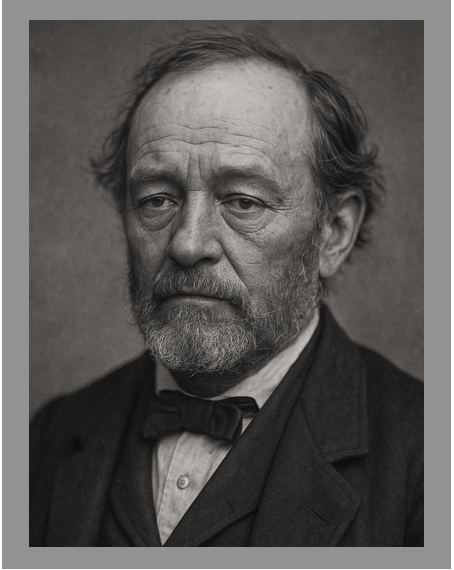John E. Fitzgerald
There are no actual photographs of John E. Fitzgerald in existence. The above is an AI-generated photo of what he may have looked like based on facts known about his life.
“Agent on the Take”
The history of John E. Fitzgerald is one full of mystery and intrigue, with tall tales dating as far back as 1870. But that name became revered and all but canonized in whiskey lore when the Stitzel-Weller Distillery named one of their main brands, Old Fitzgerald, after him.
According to one story, John E. Fitzgerald built a distillery with his own hands on the banks of the Kentucky River in the 1870s and sold his finest bourbon ONLY to rail lines, steamships, and private clubs. Since the brand was supposedly shipped all over the world, but only to exclusive clubs, the average person could never find a bottle to try. It became scarce, mystical, and people always wanted what they couldn’t have or find. The reputation of the brand continued to soar.
Another legend about this liquor was that it was first produced by an Irish whiskey maker named John E. Fitzgerald at a distillery near Frankfort, Kentucky. Solomon C. Herbst, a Prussian-born wholesale wine and liquor dealer in Milwaukee, knew the tale well. In fact, Herbst actually wrote the script for the story himself when he bought the distillery. Like many wholesalers, Herbst looked for a guaranteed flow of supplies of bourbon. Around 1890, he found and bought a small distillery located outside Frankfort on Benson Creek. The locals called it the “Old Judge Distillery” for its flagship brand. In Federal parlance, it was known as Registered Distillery #11 of the Seventh Revenue District.
The actual “Old Fitzgerald” brand was first registered in the 1880s by Solomon C. Herbst and produced in such limited quantities that it was very difficult to find outside Franklin County, the county in which it was produced. Because of that, “Old Fitzgerald” became one of the first “allocated” brands.
Agent Fitzgerald apparently had a particularly discerning palate for fine bourbon and would use his rickhouse keys to gain access to the very best barrels. The Stizel-Weller warehouses stood seven stories in Shively, Kentucky. Fitz had an affinity for the fifth floor, and occasionally, an employee would find a hidden whiskey thief, wet from sampling, under or behind fifth-floor barrels. Those lighter barrels would eventually become known around the distillery as “Fitzgerald barrels”. The distillery manager could tell the best barrels just by their lighter weight. Herbst first, and then Pappy, immortalized the man who had both the keys and the fine taste by naming the brand after him: “Old Fitzgerald”.
Now owning his own plant, Herbst began to fashion a myth for it. He recognized that giving his own Prussian name to the distillery might not resonate very far in Kentucky, so he spun a story, which is still perpetuated, that the distillery had been run by an Irish master distiller named John E. Fitzgerald who then sold the facility and the recipe to him. Fitzgerald supposedly had then moved to Indiana, to run another distillery, so the story went.
The brand was eventually sold to Julian P “Pappy” Van Winkle during Prohibition when the distillery could not produce any whiskey. Pappy moved production of Old Fitz to his distillery, where it became the first great wheated Bourbon, and then eventually, one of the most famous bourbon brands in the entire world.
Fitzgerald’s actual identity was revealed in a family biography of the Pappy Van Winkle’s family, the book titled “Always Fine Bourbon,” by Pappy’s granddaughter Sally Van Winkle Campbell. In that book, it is revealed that John E. Fitzgerald was not at all the man he had been portrayed to be. He was not a Distillery Owner who built his distillery with his own hands, NOR was he an innovative Irish Master Distiller who crafted the world’s finest bourbon. He was, in fact, a bonded U. S. Treasury Agent, who at the time was the only person legally allowed to carry one of only two keys in existence to the envied Stitzel-Weller barrel storage rickhouses. Being resourceful, Fitzgerald purchased the distillery’s first key from an employee before he left the employment of the distillery, so he always possessed both keys needed to get into the bonded warehouse.
Despite William Larue Weller’s attempts to convince sophisticated whiskey drinkers that wheated Bourbons were better, the brands of Old Rip Van Winkle and Old Weller were limited in success and confined to a niche audience. It wasn’t until Old Fitz became a common household brand throughout the middle class that a wheated bourbon was then considered a preferred favorite.
The Stizel-Weller distillery once produced brands such as W. L. Weller, Old Fitzgerald, Pappy Van Winkle, Old Weller, Old Rip Van Winkle, Rebel Yell, and Weller’s Cabin Still. But when the distillery closed in 1972, Rebel Yell was sold to The David Sherman Company, which evolved into LuxCo. W. L. Weller, Old Weller, Pappy Van Winkle, and Old Rip Van Winkle were sold to the Ancient Age Distillery, which would eventually morph into Buffalo Trace. Both the Old Fitzgerald brand and the Cabin Still brand were then sold to Heaven Hill.
In 2017, the owner of the old Stitzel-Weller Distillery, Diageo, restarted bottling Bulleit Bourbon at the site.
Nothing more was ever heard from Agent Fitzgerald nor of his exceptional palate.
Contributed by Colonel CRaig Duncan, Columbia, Tennessee
Special thanks to Heaven Hill Brands for much of the factual information in this story






